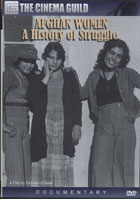
Afghan Women: A History of Struggle 2007
Distributed by Cinema Guild, 115 West 30th Street, Suite 800, New York, NY 10001; 212-685-6242
Produced by Kathleen Foster
Directed by Kathleen Foster
DVD, color, 69 min.
Sr. High - Adult
Gender Studies, Middle Eastern Studies, Women's Studies
Date Entered: 10/15/2008
Reviewed by Gloria Maxwell, Reference Librarian, Penn Valley Community College, Kansas City, MO80% of the people in Afghanistan don’t feel liberated. That startling fact opens this powerful film that documents the history of Afghanistan from 1964 to the present. Fundamentalists still control the government. 90% of the women can’t read or write. The rape and abduction of first marriages is rampant. Many women attempt suicide by burning themselves with cooking oil, so unhappy are they in their lives. Most of the women say it’s good that the Taliban are gone, but it doesn’t mean that they are liberated. The Constitution of 1964 (to 1973) gave equality to women under King Mohammed Zahir Shah and Queen Homaira Shah. The government was secular and the country was religious. This was a time of tolerance, yet there was social injustice, too. With archival footage and interviews, the film documents the country’s history through the efforts of women who participated in the revolutionary movement of the 1970s and the political turmoil that followed from civil war, to the Taliban, to Soviet and United States intervention. War lords, Taliban, Mujahidin, and the cold war contest between the U.S.S. R. and the U.S.—all wreaked destruction, havoc and turmoil. The most disturbing section relates to the CIA’s role in creating terrorist groups along the Afghan-Pakistan border, which haunts the world today. Interspersed with historical events is footage of a conference at Kandahar in which women from across Afghanistan work on drafting an Afghan Women’s Bill of Rights. As these women talk they dispel the idea that the notion that the expulsion of the Taliban government has brought them freedom. Today, 70% of Afghanis live on $2.00 a day; life expectancy is 45; 1 out or 5 children die before the age of 5; maternal mortality is 1600 per 100,000 (the second highest rate in the world). Since the U.S. invasion, Afghanistan exports 87% of the world’s opium; the majority of the members of their Parliament are former war lords or Mujahidin; and, the Taliban is returning. The U.S. has two permanent bases and 30 smaller ones throughout the country.
Audio and video qualities are very good. The addition of archival footage for the historical segments greatly enhances the documentary.
This film is suitable for high school and college collections. This should be required viewing for history and women’s studies classes. The elements of the film are sure to invite discussion. This is an exceptionally powerful documentary that should be required viewing. Highly recommended.